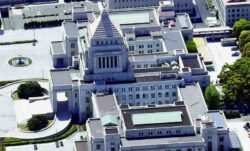フォーム
“The different streams, having their sources in different places, all mingle their water in the sea.”
In 2007, then Prime Minister Shinzo Abe delivered what would later be remembered as an epoch-making foreign policy speech, titled “Confluence of the Two Seas,” in the Indian Parliament. Beginning his widely acclaimed speech with a quote from the Indian spiritual leader Swami Vivekananda (1863-1902), Abe went on to deliver a profound insight: “The Pacific and the Indian Oceans are now bringing about a dynamic coupling as seas of freedom and of prosperity.”
Abe’s speech reframed the Indian Ocean and the Pacific Ocean as one united ocean: free and open. Nearly a decade later, his vision became the Japanese government’s official diplomatic policy, the free and open Indo-Pacific.
No other Japanese diplomatic strategy of recent decades has had as much influence on geopolitics as the free and open Indo-Pacific. As Russia’s invasion of Ukraine and China’s military pressure on Taiwan pose increasing threats to the existing international order, the free and open Indo-Pacific has become the canon among defenders of that order.
Tragically, Abe was killed on July 8.
U.S. President Joe Biden, Australian Prime Minister Anthony Albanese and Indian Prime Minister Narendra Modi — three of the leaders of the Quad, a framework for cooperation among Japan, the United States, Australia and India — released a joint statement that day mourning Abe’s death. The statement read, “Abe was a transformative leader for Japan and for Japanese relations with each one of our countries” and said that he “worked tirelessly to advance a shared vision for a free and open Indo-Pacific.” It should not be forgotten that the Quad itself is another important Abe legacy.
He will be remembered on the international stage for these bold foreign policies.
Abe’s leadership style was similarly applied to other parts of his policy agenda. Known also for his mantra of “cast off the postwar regime” during his first Cabinet (2006-07), Abe’s drive to overthrow Japan’s postwar political restraints was enthusiastically accepted by some of the public. However, Abe was also a controversial figure and he was embroiled in multiple scandals during his long tenure in power.
It is ironic that Abe’s death put Prime Minister Fumio Kishida in a tight political bind. While Kishida’s Cabinet approval rating remained solid at over 50% for most of the first year of his administration, and even went as high as 66%, it tumbled by 20 points from July to October in Yomiuri Shimbun surveys.
The reasons that political observers offered for the swift decline are associated with issues surrounding connections between the Unification Church and the ruling Liberal Democratic Party (LDP), which surfaced after Abe’s death. When Kishida announced his plans to hold a state funeral for Abe, there was also some public backlash over that.
However, Kishida’s problems, and the LDP’s for that matter, may be more deeply rooted. The overwhelming majority of the public is increasingly frustrated with Kishida for apparently not showing enough leadership. In fact, 80% of respondents to an October poll conducted by The Yomiuri Shimbun said that Kishida lacked leadership in response to the Unification Church issues.
Why did this happen? The answer lies in the relationship between Kishida and Abe. To be blunt, Kishida relied too heavily on Abe’s power to govern the party and country.
In terms of party politics, Kishida can be said to have adopted the “ellipse theory” championed by Masayoshi Ohira, who was the prime minister from 1978-80. He held that overall harmony can only be achieved by balancing the two centers of an ellipse. Kishida and Abe were two centers of the ellipse and Kishida was able to stabilize the ellipse by showing respect and consideration to Abe and his allies.
In fact, Kishida was chosen as a leader in a backlash to Abe. Abe’s speech in India, in which he depicting water flowing into the ocean from different sources, is reminiscent of the LDP itself. The LDP, which has established a unique one-party dominance rarely seen anywhere else in other democracies in the world, is a party that brings together political powers with a truly broad range of ideologies. Abe came from the most conservative faction of the party, while Kishida came from the most liberal-leaning faction. While Abe was an aggressive leader, Kishida seems to be more a coordinating type. If Abe was a soccer player, he would be a forward; Kishida would be a defender. Indeed, Abe and Kishida were a study in political contrasts.
As the longest-serving prime minister in Japan’s constitutional history, Abe survived multiple challenges and calls for political change. When Abe stepped down due to illness, his successor, Yoshihide Suga, who advocated a continuation of Abe’s policies, was able to stay in office for only a year. His political logic was similar to Abe’s, but he lacked Abe’s skill at persuading the public. After that, Kishida, who had a different background and ideology, was chosen as the prime minister following Suga. A senior LDP official once gave me the following analysis to explain why Kishida was chosen. “After eating steak every night for a long time, people want to eat Japanese food.”




